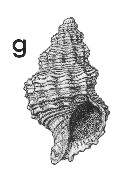
Revised descriptions of New Zealand Cenozoic Mollusca from Beu and Maxwell (1990)

 | Revised descriptions of New Zealand Cenozoic Mollusca from Beu and Maxwell (1990) | 
|
  (Pl. 37g): topotype (paratype?) from Suter's material of Siphonalia turrita, Lake Kaniere, Westland, (Opoitian? or) Waipipian? (GNS) |
Beu & Maxwell (1990): Chapter 14; p. 298; pl. 37 g.
Synonymy: Fusus nodosus var. D Hutton 1873b, p. 3; Siphonalia turrita Suter 1914, p. 24 (not of Tenison Woods, 1875); Aethocola pagoda Finlay 1924a, p. 103 (new name for S. turrita Suter, preoccupied)
Classification: Buccinulidae
Description: Moderate-sized for subgenus (36-55 mm high), with prominent shoulder angle and strongly stepped spire, prominent spiral sculpture, and (for subgenus) relatively short, strongly twisted anterior canal with fasciole bordered by prominent, narrow ridge. Sculpture of prominent, narrow spiral cords; typical Kaniere shells and many from other localities have 1 very prominent cord at shoulder angle, 2 more on a less marked peribasal angle, 4 similar strong cords on base and canal, a single slightly weaker cord halfway between the 2 angulations, and 4 or 5 low cords on sutural ramp, with a variable number of fine interstitial lirae in major interspaces; but details of spiral cord prominence and number vary widely. Cords cross high, narrowly rounded, moderately widely spaced axial costae, 12 to 16 per whorl, extending from suture to peribasal angulation, forming small, narrow nodules at sculptural intersections. Aperture large, oval to subrectangular, with about 12 lirae inside outer lip. Protoconch small, conical, with sharp apex, of about 3.5 smooth whorls.
Comparison: Aethocola pagoda is the common Pliocene species of "typical" Aethocola, apparently ancestral to and occupying the same niche as A. taitae (Nukumaruan; Pl. 42k) and A. glans (Castlecliffian-Recent; Pl. 49c). All closely related species have more numerous, weaker spiral cords, in particular lacking the few prominent basal cords seen in most collections of A. pagoda, and A. glans reaches a much larger size. A. pagoda has been thought of as a restricted Waipipian species previously, but Opoitian specimens from many localities are little different from Kaniere specimens, and the typical coarsely spiralled form ranges into Mangapanian in Wairoa district (as do such previously "Waipipian" taxa as Aethocola pliocenica, Coluzea spectabilis, Semicassis (Kahua) aff. fibrata, and Clavatoma pulchra). Suter (1914, p. 24) named Hutton's variety D of Fusus nodosus (i.e., A. glans) as Siphonalia turrita, and Finlay (1924a, p. 103) provided the similar name Aethocola pagoda for the preoccupied S. turrita. Suter's material of S. turrita, in NZGS, consists of several relatively large, strongly sculptured specimens from GS145, Lake Kaniere; the age could be either Opoitian or Waipipian. Adoption of Aethocola is discussed under A. acuticostata (Pl. 6m).
Distribution: Opoitian-Mangapanian; Lake Kaniere, Westland, Waipipian? (type); common and widespread in mid-outer shelf assemblages in mudstone throughout New Zealand, and particularly common in the Wairoa district, northern Hawke's Bay, and in Westland.
Cite this publication as: "A.G. Beu and J.I. Raine (2009). Revised
descriptions of New Zealand Cenozoic Mollusca from Beu and Maxwell (1990). GNS
Science miscellaneous series no. 27."
© GNS Science, 2009
ISBN
978-0-478-19705-1
ISSN 1177-2441
(Included with a PDF facsimile file
copy of New Zealand Geological Survey Paleontological Bulletin 58 in CD version
from: Publications Officer, GNS Science, P.O. Box 30368 Lower Hutt, New
Zealand)